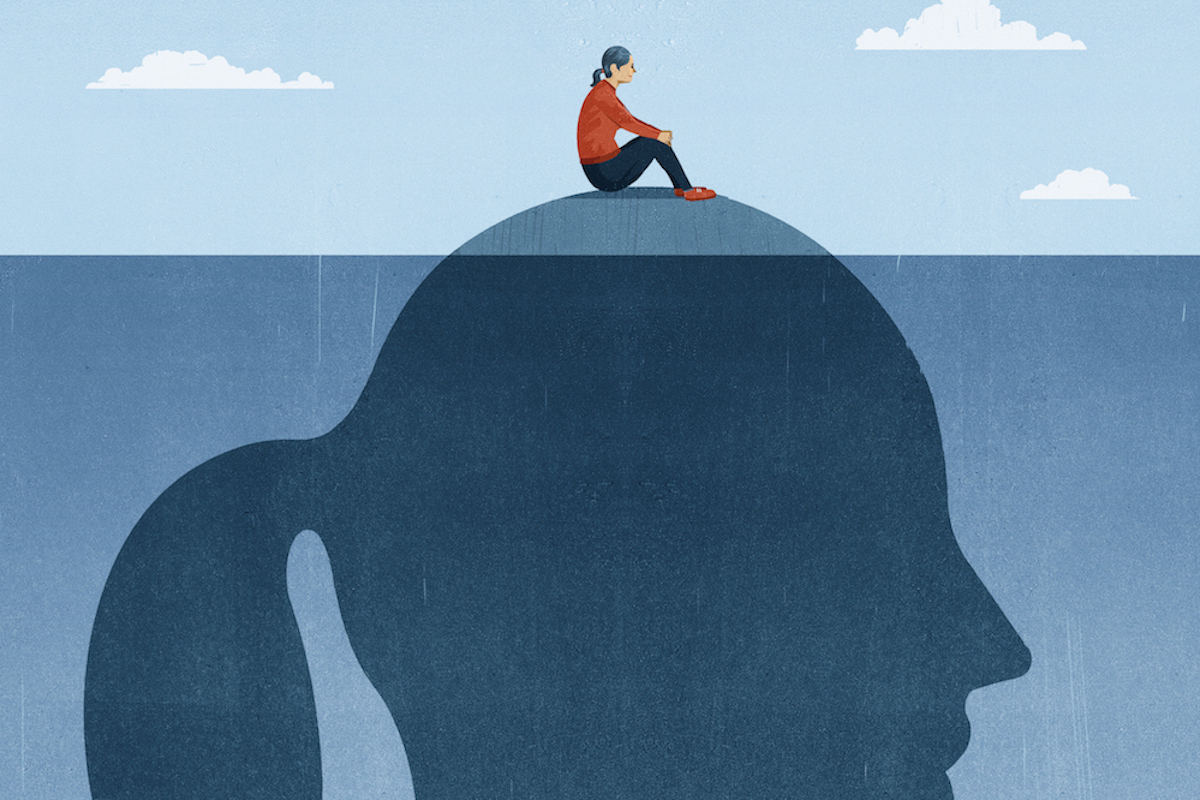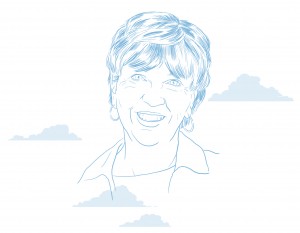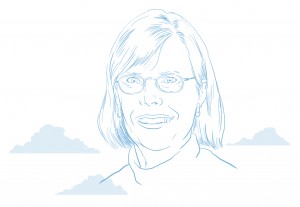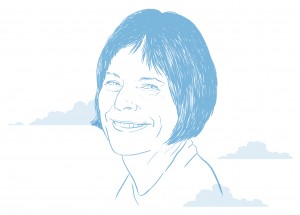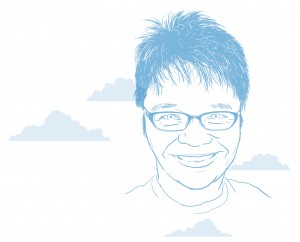Goucher explores the science and practice of mindfulness
By Angie Cochrun
The idea of mindfulness can be intimidating and confusing for some, while others find it to be a source of peace and contentment. Bridging that divide is one of the reasons Goucher is hosting a series of initiatives centered on the science and practice of mindfulness this spring. The themed semester will explore public presumptions about mindfulness, its impact on the quality of life, and the diverse ways contemplative practices figure into secular and religious lives.
Goucher Magazine spoke with four alums who engage with mindfulness in their own ways. For up-to-date information on panels, speakers, and events related to mindfulness, visit goucher.edu/mindfulness.
Although Debra Landwehr Engle MFA ’04 began her freelance career writing for magazines such as Country Home and Better Homes and Gardens, she always has been drawn to spirituality, personal growth, and the role
of mindfulness in both. A divorce in her late 20s renewed her interest in mindfulness, which she calls “the simplest and hardest thing in the world.”
In 2003, the Iowa resident authored a book titled Grace from the Garden, Changing the World One Garden at a Time. Her most recent work, The Only Little Prayer You Need: The Shortest Route to a Life of Joy, Abundance, and Peace of Mind, was published last year. It includes a foreword written by the Dalai Lama, who noted that “Peace in the world relies on individuals finding inner peace.”
Engle, who teaches mindfulness classes as well as writing workshops, is working on another book, scheduled to be published in September. Her research and writing focus on the idea that many thoughts and decisions are determined by fear. “There’s an ego-based part of us driven to prove we’re good enough, successful enough, and that we can control things, which is exhausting,” she says. Even a short meditation session, focusing only on breath, can draw people out of a negative mindset. “It’s very difficult to be distracted by the past or future when you’re focused on that next breath.”
Mindfulness requires a lot of discipline, Engle says. Once you’ve recognized its benefits and committed to individual practice, that discipline becomes easier. Her mindfulness regimen includes daily communication with the spirit that she calls “that voice inside of me that connects me with something bigger.”
“I hesitate to use ‘God’ or put different names on it,” she says. “I’m very respectful of others’ spiritual and religious beliefs.”
To help beginners form the habit of mindfulness, Engle suggests putting a mantra or prayer where it’s easily visible, such as on the car dashboard or a mirror, or using it as the wallpaper on your cell phone. “What we’re really doing is retraining our minds to focus on something different than what the world wants us to focus on,” she says.
Even small steps can make a big difference in how you view your place in the world and what you have. “Gratitude is a huge part of mindfulness,” she says.
There’s one thing you won’t find in the home of Lucy Hedrick ’69: Clutter.
“When people are surrounded by piles or halfway-done projects, it hinders you. Clutter is very immobilizing,” says the Connecticut and Florida resident. “I feel there’s a huge payoff in reducing clutter because mindfulness comes more easily if you have less to tune out.”
The author of multiple books, including Five Days to an Organized Life, 365 Ways to Save Time, and Get Organized in the Digital Age, Hedrick says that while it’s not impossible to be clear-minded in a cluttered area, it’s much easier when not surrounded by dozens of things.
Tidying up seems to have particular resonance these days as the population ages and empty-nesters downsize to smaller homes and fewer belongings, Hedrick says. But no matter your age, a space free of belongings can contribute to a more easily focused mind. “Many, many possessions require a lot of brain space,” she says. Even technology and all it entails produces its own brand of mind-clutter.
Although the author has never meditated, she has multiple tools in her arsenal to aid her mindfulness.
“I make sure to immerse myself in nature at least once a day,” Hedrick says. “I sing in a choir, and that’s mindfulness. I tune everything else out.”
Writing her next book, a historical novel based on her grandmother’s life, is a daily practice, as is visiting a nearby botanic garden or the beach and concentrating on the sand. And mindfulness can be communal—she nixes the idea of practicing yoga on her own and chooses, instead, to attend a class. “I go to be with 24 others to practice yoga, so I won’t sabotage and say,
‘I better do the laundry,’” she says.
Focusing on mindfulness has greatly contributed to her physical and mental well-being. “I have no idea what throws the switch, but us old people sometimes can lose our short-term memory and remember all the bad things that happened in kindergarten,” she jokes. “For me, mindfulness focuses on cheerful thoughts.”
Clinical sociologist Kathryn Goldman Schuyler ’67 has studied personal and societal change throughout her professional life. In her research, she seeks to understand how to create long-term change and what kinds of leadership generate societal health. “Leaders need to fine-tune themselves: They need to listen deeply to themselves and others in order to be present to people in all situations,” says the Alliant International University professor.
Mindfulness informs her personal life, as well as her scholarly work. Goldman Schuyler practices Tibetan Buddhist traditions and is a teacher of Awareness Through Movement, as developed by physicist Dr. Moshe Feldenkrais, with whom she trained. She finds the Feldenkrais practice—which seeks to reduce pain, improve physical function, and enhance one’s learning capacity—is a powerful way to help people move through life. In her writing on leadership, embodiment, and mindfulness, published recently by the International Leadership Association, she portrays the way that awareness lives in the body (not just in a disembodied “mind”) and is the source of authentic action.
According to Goldman Schuyler, the most widespread approaches to mindfulness are used more for stress reduction than for its original purpose: developing wisdom and insight into life. She teaches mindfulness training programs to help people to develop techniques for calming themselves.
In her own work, Goldman Schuyler focuses on insight, awareness, and awakened action. She blends her personal practice of awareness and her scholarly interests. She recently completed a multi-year action research project on being fully present at work, and she co-authored a 2014 book about mindfulness for leaders (with Goucher Visiting Associate Professor of Sociology John Eric Baugher and others) titled Leading with Spirit, Presence, and Authenticity. She and Baugher will have a new book out this spring, titled Creative Social Change: Leadership for a Healthy World.
Goldman Schuyler suggests that newcomers to mindfulness remain open to all approaches while being aware of their differences and seeking what speaks most deeply to them. The disparate approaches are not unlike Thai, Mexican, and French cuisines, she says. “They have completely different flavors, but they’re all food. If you mix them in one dish, the taste would not work. But eaten separately as prepared by a master chef, each is delicious and nourishing.” And all approaches to mindfulness help leaders sustain vision, connectedness with people, and their own health.
Are you happy with your life? Is it working for you?” asks La Sarmiento ’86, a Dharma teacher, mentor, retreat manager, workshop producer, bodyworker, and reiki instructor who has spent years helping others approach mindfulness. “If not, mindfulness is a good way to get in touch with why.”
Mindfulness “saved my life,” says the Washington, DC, resident. Born in the Philippines, Sarmiento, immigrated as an infant to the United States. Often the only person of color in college social circles, Sarmiento, who has identified as queer since age five, struggled with self-acceptance. A rough breakup years ago led Sarmiento to understand that inner peace is a prerequisite to well-being and the ability to meet whatever arises in life with wisdom and compassion. “The two can be a tandem process,” Sarmiento says.
Mindfulness is not merely about reducing stress; it is fully understanding ourselves and how we’re deeply conditioned to see ourselves and the world from infancy on. “I’m not big on teaching people on how to meditate so they can deal with their stress; my aspiration is that they can wake up and be citizens of the world,” Sarmiento says. “I try to meet whatever experiences I have with as much compassion and kindness as I can. If we blame ourselves, we’re never going to be free.”
Sarmiento has made teaching mindfulness a lifelong pursuit, although, “It’s not where I thought my biology degree would take me.” Through the Insight Meditation Community of Washington, Sarmiento leads mindfulness groups for lesbian, gay, bisexual, and transgender students, as well as people of color. “Often people think of mindfulness as a predominantly white, upper-middle-class thing, but it doesn’t have to be.
“I believe that the purpose of life is not about being happy; it’s about being fully alive,” Sarmiento says. “I think it’s important in the world today to cultivate a heart that’s ready for anything: loss, violence, love, and relationship, and just to be with however life unfolds. … We have no control over it.” Mindfulness, experienced through such things as meditation, is a way to confront yourself, according to Sarmiento. “In this culture, we’re watching others’ reality shows, but mindfulness helps you watch your own.”

